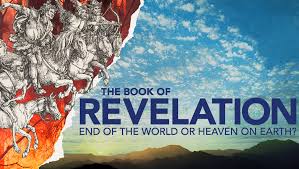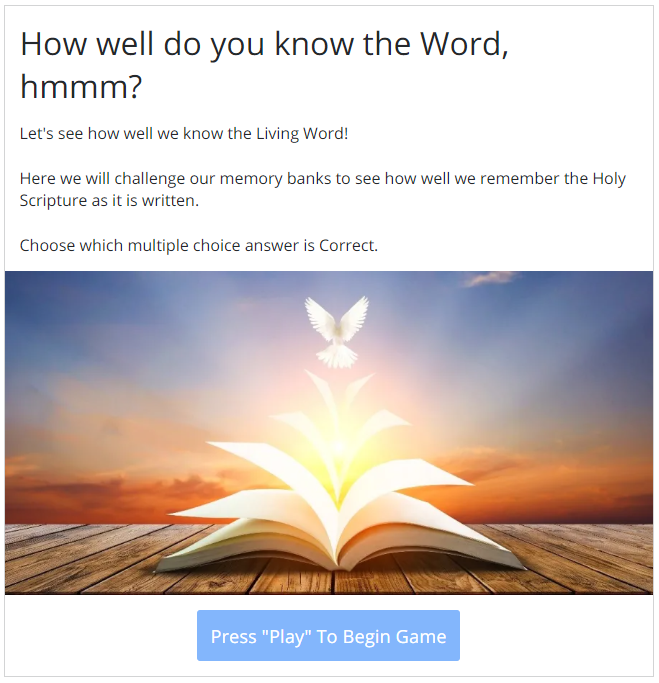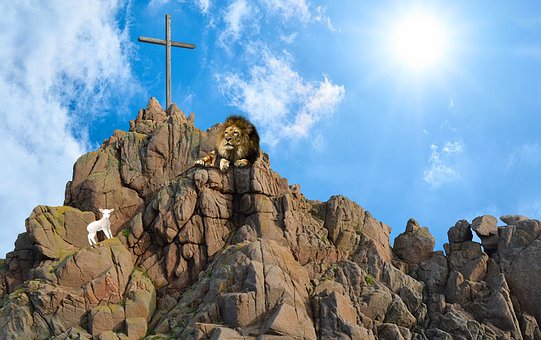Letter to the seven churches
From John, the apostle
On the island of Patmos in the Aegean Sea, a prophet named John writes to congregations of faithful but frightened Christians in Asia Minor. Under the dim light of an oil lamp, John paints a picture of the vision he was given of the world that is and that is to come.
This book of letters and visions is to be sent to the hardy churches that have stood strong through persecutions, heresies, and many temptations. However, knocking at the door are Satan and his forces. They are encroaching on the domain of God’s kingdom.
Establishing an everlasting order
Satan’s minions, led by the beast and the false prophet, are ready to battle the armies of heaven. This war that begins in the celestial realm spills over to the world below. While the nations of earth rally around the banner of the evil one, heavenly messengers prepare for a battle that has all of creation at stake.
Still, as John knows, the Lamb-King has already vanquished evil in the world. John’s ink-stained hands write of the One who is renewing all of creation and establishing an everlasting order. God has Rome and all the powers that rule the earth on a short leash. Soon the nations of the earth will see the All Powerful, the One who has given His life for the many. This is the future as it has been unveiled to John.
John’s apocalyptic images
John writes of what he sees and hears in his vision. Sometimes he hears one thing but turns to see something altogether different. Sometimes he sees multiple images of the same event as if he is viewing it from different perspectives. These visions are dynamic; they far exceed contemporary imagery and are far superior to what can be produced on film or through television.
John’s apocalyptic images challenge the imagination. The imagery in Revelation involves numbers, word pictures, and symbols that held religious and political significance for the churches in Asia Minor. Many of the images come from the Hebrew prophetic literature of Isaiah, Ezekiel, and Daniel, as well as other non-ancient Jewish texts.
John’s audience did not need a guide to interpret the ciphers; each image was relevant to them. However, those living in a twenty-first-century context must decipher these images to understand what they meant for John’s world and what they mean today.
Revelation 2:1
As the story unfolds, we’re told that the lampstands signify the churches. During harsh times of persecution, the faithful often wonder where their Master is. Is He even aware of what they are experiencing?
John’s vision confirms what the gospel already teaches: Jesus is present with them even in their suffering, moving among those who dare to bear the light. Lampstands, of course, are not the light. They only carry the light. The true Light that has come into the world is none other than Jesus, the Son of Man (John 8:28).
Revelation 3:1
For centuries many Jews had been scattered throughout the known world, exiled to the lands east of the Jordan River from the promised land by powerful invading nations. After Jerusalem fell in A.D. 70, even more Jews left Judea, this time crossing the Mediterranean looking for some place far from Roman cruelty.
That’s why, as John writes these letters to churches in Asia Minor, he recalls some of the most infamous characters from Israel’s past — Balaam, Balak, and Jezebel. The ordeals facing John’s churches are not all that different from those Israel faced hundreds of years before.
Many of the same struggles plague churches in the West to this day. The names may change, but the problems confronting God’s faithful do not.
Revelation 5:1
Throughout this book of letters and visions, numbers play an important role. Numbers and their multiples are signs of great mysterious realities. The Son of Man moves among seven lamp stands and holds seven stars in His right hand because the number “seven” represents perfection and completeness.
Another important number is “twelve” because it represents the people of God. The children of Israel consisted of twelve tribes, and Jesus called “the twelve” to follow Him and embody the new covenant.
The number “twelve” and multiples of “twelve” recur throughout the book to signify the people of God, so here the twenty-four elders (12 + 12) signify the people of God, both the old and new covenants.
Revelation 5:7
John hears that the Lion of the tribe of Judah, the Root of David, has arrived and will open the seals to reveal the scroll’s mysteries. But when he turns to see the Lion, he sees a Lamb instead. Not everything is as it appears.
The Lamb stands, even though He has been slaughtered as a sacrifice, because He has been resurrected from the dead. And now in his vision, John sees things as they truly are: the Lamb-King has seven horns and seven eyes, signifying the perfect power and perfect sight He possesses to rule the world.
Revelation 6:9
The breaking of the seals releases the four riders and a series of disasters and plagues. Even though what follows appears to be extreme violence unleashed against the earth and its inhabitants, there is a limitation to what follows.
Death and Hades have the authority to kill, but their authority extends only to one-fourth of the earth. The slaughtered souls cry out for vengeance, but they will have to wait a little longer until more martyrs are killed for their testimony.
Revelation 7:11
John hears that 144,000 people out of Israel are destined to be sealed, but then he turns to see an innumerable multitude from every people group in the world. What he sees reveals the truth of what he hears: the number “144,000” is not an exact count of who will be saved but is a symbolic number (12 x 12 x 1000). “Twelve” is a number that signifies all the people of God, from both the Old and New Testaments.
In reality, between the sixth and seventh seal, there is an interlude, an opportunity for people from every nation to enter into the people of God, to receive God’s mark, and to take their places among the redeemed.
Revelation 11:1
The scroll John eats is taken from the hand of the powerful messenger who announces the fulfillment of all the prophecies. Just as it did for the Old Testament prophet Ezekiel ( 2:8–3:4 ), the scroll represents the message John is required to proclaim; but first he must take it in and it must become a part of him.
Initially it tastes sweet, but as it settles deep within him, it becomes bitter. God’s message is always bittersweet. It is sweet joy for those who turn to God, but bitter sadness for those who do not accept it.
Revelation 11:7
The two witnesses bear a striking resemblance to the faithful prophets of Israel and the faithful martyrs of the churches. Together they stand speaking God’s message as the nations rant and rave and trample the holy city. The lampstands, which signify the churches, are not the light, but they welcome the light and present it to the world.
The olive tree, even today, is a symbol of Israel. Olive trees supply the oil for the lamps so that they may burn brightly in the darkness. For a season, the two witnesses enjoy God’s protection, but a time is coming when they will fall victim to the nations and then lie silent.
Revelation 11:16
When the seventh messenger blows his trumpet, the kingdom of this world comes to an end. The rule and reign of God and His Anointed has arrived in full to eclipse the rogue kings who rebelled against the Creator and mocked His good name. God’s kingdom entered our world in the incarnation, death, and resurrection of Jesus.
It slipped in almost unnoticed beneath the noses of the powers that be. It grows silently as a seed in the earth until it fills the cosmos. Today Christians live between the times: we live as aliens and strangers rescued from this present darkness, but we also live as citizens who long for the Kingdom that is to come. Until then we are to seek His kingdom and help carve out the territories for Him.
Revelation 12:7
The sign that appears in the vision is of a celestial woman who gives birth to a son. While it’s possible this could refer to Mary, the mother of Jesus, it is also possible this is a symbol of God’s chosen people.
The faithful remnant of Israel is the womb that carried the Lord and delivered Him to the world. While the great red dragon does his best to destroy and devour Him, God has another plan. Since then, the dragon and his minions have done their best to harangue and persecute the woman’s children. But again he does not have the final word.
Revelation 13:5
The beast emerges from the murky waters resembling the dragon; but it has other features, too, that resemble the four beasts as described in Daniel 7. Daniel, in his visions, learns that the beasts represent the empires that terrorized Israel and the rest of the world: the Babylonians, Persians, Medes, and Greeks. Prophetic images are difficult to identify.
The beast in John’s vision could be none other than the Roman Empire or another empire to come later. Rome has its own beastly authority, the Caesar, who demands worship. “Caesar is Lord,” they dare to claim. But John knows better. In every generation, powerful people and institutions arise — political predators that demand loyalty, sometimes even worship.
Revelation 13:12
The second beast, which later becomes “the false prophet,” has horns like the lamb; but its true nature is revealed in its dragon-like voice. Many pretenders and posers exist in the spiritual world. This new beast wants the world to believe it represents the True God, the only King worthy of worship.
But it’s a deceiver, a counterfeit of the true King; it steals devotion away from the one true God, producing signs to dazzle the inhabitants of the earth.
Revelation 14:1
The number “666” stands in contrast to the perfection of the Lamb and the Spirit. Because this number is “the number of a person,” readers have tried to pin down the identity of this person throughout history. In John’s day, the name and title “Nero Caesar” was a likely candidate for the beast because Nero persecuted and executed believers, demanding obedience and even worship.
Every era seems to have its Neros, those beastly characters who occupy seats of power and yet use their power to oppress God’s people. The speculation continues as to this person’s identity, but what has not changed is the message of hope in the midst of extreme persecution; that is the beauty proclaimed in this vision given to John.
Revelation 16:15
The dragon, beast, and earth-beast are an unholy trinity who send out demonic spirits. These spirits resemble frogs and remind the reader of the plague of frogs that invaded Egypt before the exodus. These foul spirits roam the world, persuading the kings of the earth to assemble together to do battle against God and His chosen.
Revelation 16:17
Har-Magedon means Mount Megiddo and is sometimes transliterated “Armageddon.” This refers to the battleground where the armies of the earth, led by the forces of evil, will assemble to mount their final attack against God.
This place is often associated with the plain of Megiddo in northern Israel because the fertile land there has often been turned into fields of blood during gruesome battles. In a place like this, for one last time, evil will raise its ugly head against good.
Revelation 18:1
Because Babylon is the city responsible for the destruction of Jerusalem’s first temple in 586 B.C., John uses this ominous symbol to describe the Babylon of his day — Rome, the city on seven hills. In A.D. 70, the Roman armies march against Jerusalem, destroy the second temple, and scatter the Jewish people.
The prostitute, who is identified as Babylon, is a symbol to readers in John’s day of Rome and its allure. Its beauty and power are legendary, but beneath the surface lies the truth of its nature. People who ally themselves with Rome and all that it represents are partners with ruin.
In the years since John’s Revelation was first written, the prostitute has been seen as many different world forces. What Rome represents in John’s day has been replicated by many different world powers and their material attractions.
Revelation 19:8
The church that suffered and remained pure is now prepared for a time of glorious celebration. As Israel has been the bride of God, now the church — the bride of the Anointed One — will be intimately united with the Lamb.
God and His people are about to become one. The marriage feast has been arranged at great expense, and the festivities are about to begin. But before the wedding, some things need to be put in order.
Revelation 20:1
In one of the final, decisive battles, the rider on the white horse leads the armies of heaven against the enemy armies of the beast and the false prophet. His enemies are easily defeated, and the beast and the false prophet are thrown into the lake of fire. When the battle is over, the rider known as “King of kings and Lord of lords” turns His attention to the dragon.
Revelation 20:11
Since the beginning, Satan, the dragon, has brought trouble on all the sons and daughters of Adam. Now John sees the truth of his destiny. Ultimately the one who brings such pain and sorrow upon the world will be bound and thrown into the lake of fire.
But evil is not easily defeated; John watches as he mounts one last, futile attack against God’s people and His beloved. Never again will he raise his ugly head against those who remain faithful to the One who sits on the throne and to the Lamb.
Revelation 21:9
John sees an amazing sight. It is something no one had ever seen nor will ever see until that day arrives. Scene by blessed scene passes before the prophet. Finally he is transported to the end of history only to discover it is no end at all; it is a new beginning.
The prophecies — every last one of them — are coming true. God’s plan will be accomplished on earth as it is in heaven when the new Jerusalem comes down and He lives among His people. All things will become new.
Revelation 22:1
John had never seen a city without a temple. In fact, every city John ever entered had many temples dedicated to many gods — all, of course, except Jerusalem, which only had one temple. But now in his vision, he sees a different kind of city, the holy city, the new Jerusalem.
As he looks around its streets of gold and magnificent buildings, he sees no temple reaching into the sky.
No temple is needed in this city because God and the Lamb live with them, constantly in view. Their throne sits prominently in the city. Their light forever illumines its streets and citizens.
Revelation 22:3
Fed by a crystal clear river is the tree of life. In the beginning, Adam and Eve were prevented from eating from the tree once they were expelled from the garden of Eden.
Divine creatures and a flaming sword then stood guard at the entrance to the garden (Genesis 3:24).
Now the tree of life returns to the story, a single tree situated on both sides of the river. No one is denied access to its luscious fruit and healing leaves.
I hope that you have really enjoyed this post,
Please Leave All Comments in the Comment Box Below ↓













Thank you for sharing this truly wonderful and blissful article about the book of Revelations.
I’m happy to have realized from this article that no matter how many times I read that particular book I can still learn and gain a lot from it. God bless you for taking the time to get this out there and may he watch your steps.
Keep up the good work!
Good morning,
Thank you for the amazing feedback, I am so glad you found value in this Introduction Of The Book Of Revelation.
Blessings And Unlimited Success To You!
The Book of Revelation (Revelation according to John) is a very unusual writing in terms of theme and style compared to the others in the New Testament.
While the Gospels and apostolic epistles speak of the “Good News” brought to mankind by the Sacrifice and Resurrection of Jesus and are full of words of love, compassion, faith and hope, the Book of Revelation is a nightmarish poetic vision full of God’s wrath and fury, a cosmic vision of the struggle of light and darkness .
Hello,
Because Babylon is the city responsible for the destruction of Jerusalem’s first temple in 586 B.C., John uses this ominous symbol to describe the Babylon of his day — Rome, the city on seven hills.
The prostitute, who is identified as Babylon, is a symbol to readers in John’s day of Rome and its allure. Its beauty and power are legendary, but beneath the surface lies the truth of its nature.
People who ally themselves with Rome and all that it represents are partners with ruin.
In the years since John’s Revelation was first written, the prostitute has been seen as many different world forces. What Rome represents in John’s day has been replicated by many different world powers and their material attractions.
Thank you for your insight.
Have A Blessed Day,
Jerry